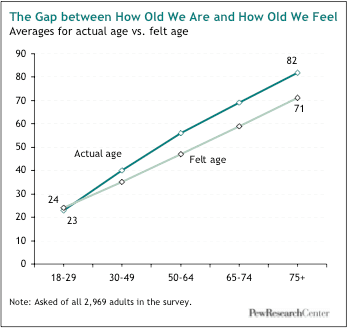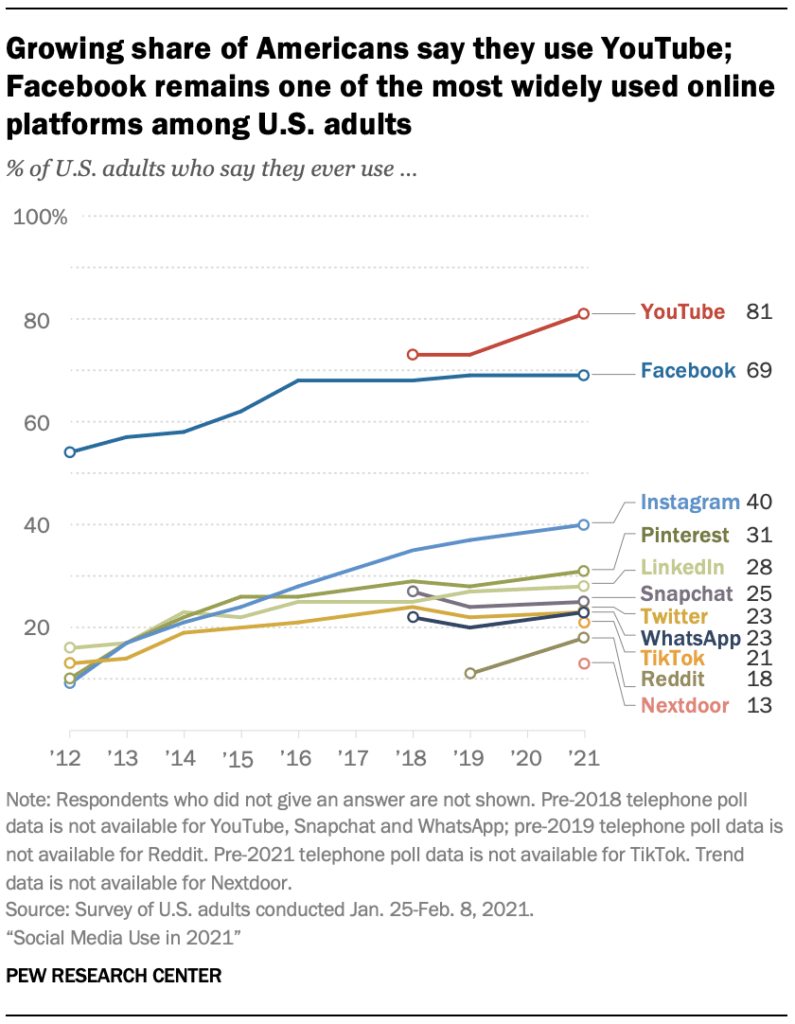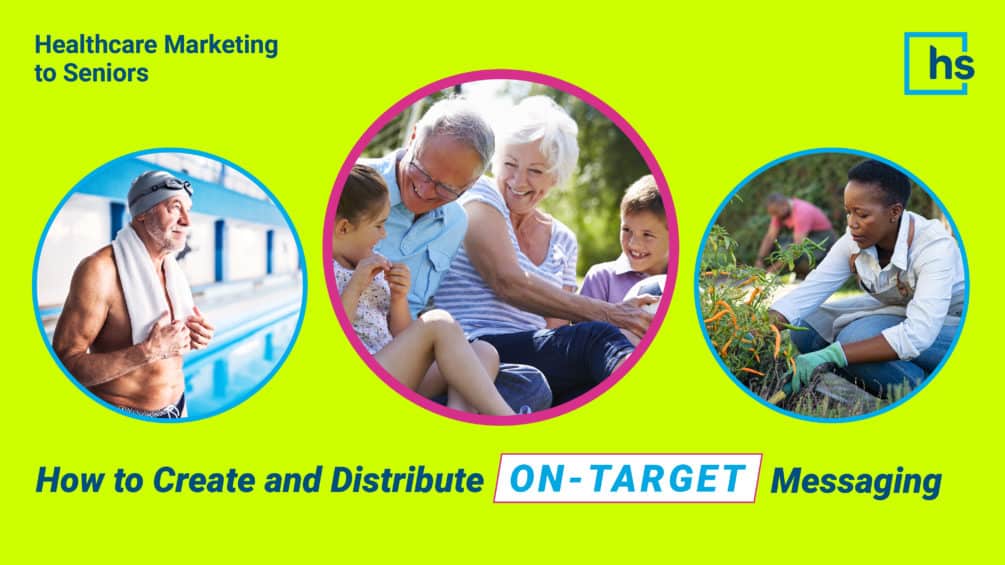Healthcare Marketing to Seniors: How to Create and Distribute on-Target Messaging
Is your content strategy for “healthcare marketing to seniors” an audience turn-off? Are you inadvertently alienating the mature audience you want to attract?
Many people targeted by marketers get genuinely upset—insulted, really—for a simple reason. This audience doesn’t like being included in the advertiser’s image of a “mature audience.” It seems to portray them as over-the-hill, strongly contrary to their younger self-image.
Collectively, by just about any measure, senior citizens are the most affluent segment of our society.
But, how old does one have to be to be considered a “senior?” While AARP and some other companies start soliciting people as soon as they turn 50, most marketers benchmark US Social Security eligibility, ranging from 62 to 70.
Is 65 the “true” senior age? Or is 65 the new 45? Sometimes, off-course healthcare messaging originates from providers, including hospitals, medical systems, or practice groups. But seniors are also bombarded with tons of retail sales pitches from AARP, pharma brands, Medicare Advantage, hearing aids, wellness devices, retirement communities, life insurance, cosmetics, and many others.
It feels like an early push toward obsolescence. Based upon the age-related avalanche, you would think consumers over 50 have no other interests besides things like hemorrhoid creams, pharmaceuticals for every imaginable ailment, chairlifts, and electric mobility scooters.
Regardless of the chronological age, they (meaning all of us) self-identify with a younger age/image. Sometimes that’s a lot younger, and the message comes across as condescending or outright insulting. Broadcast media, direct mail, and social media may be faulty if the message is taken as derisive.
How to Market to Seniors: Rethink Your Creative and Media Perspective
Many people don’t appreciate being labeled a “senior citizen” or seeing an audience picture that’s an “old and gray” individual. The unintended but unflattering translation rubs against their younger mindset. To them, it announces: “You are aging, elderly, over the hill, old-timer, geriatric, wrinkly, or downright ancient.”
Was it a 25-ish young gun in the office who created the ad? Experienced marketing professionals and healthcare communicators recognize and avoid this classic mistake. But for young communicators anxious to tap the buying power of mature Americans, this is a cautionary tale.
Here’s how to safeguard against this creative mistake and how to market to seniors.
Are Baby Boomers Considered Seniors?
Depending on your source, a typical generational breakdown lists society as six slices:
- Gen Z, iGen, or Centennials: 1997 – 2012
- Millennials or Gen Y: 1981 – 1996
- Generation X: 1965 – 1980
- Baby Boomers: 1946 – 1964
- Traditionalists or Silent Generation: 1928-1945
- Greatest or WWII Generation: 1901-1927
But for marketing minds, SENIOR most often means the BABY BOOMER cohort. “As the largest generational group in US history (until the millennial generation slightly surpassed them), baby boomers have had—and continue to have—a significant impact on the economy. As a result, they’re often the focus of marketing campaigns and business plans.”
“Baby boomers hold $2.6 trillion in buying power. They’re credited as one of the wealthiest generations to date and are still economically powerful despite their old age.”
Redefining the Persona: “I Don’t Feel Like How I look.”
You’re only as old as you feel. Marketing professionals need to consider the age people hold in their brains as their self-identified age. It’s a challenge, but research tells us the age you feel is more important than your birth year.
Studies show that: “People who report feeling younger tend to live longer and healthier lives — and they don’t tend to have as much of a pattern of decline.” In most cases, people say they feel about 20% younger than they are, according to a Michigan State study of more than 500,000 people.
This keeps ramping up as folks age. Beginning at age 50, many say they feel about ten years younger.
Respected Pew Research plots the gap between “actual” and “felt” age. “The gap widens as people grow older. Nearly half of all survey respondents, ages 50 and older, say they feel at least ten years younger than their chronological age. Among respondents ages 65 to 74, a third say they feel 10 to 19 years younger than their age, and one-in-six say they feel at least 20 years younger than their actual age.”

In some very real ways, you are ‘only as old as you feel.’ Various studies have shown that your subjective age can also predict various important health outcomes, including your risk of death. Given these enticing results, many researchers are now trying to unpick the many biological, psychological, and social factors that shape the individual experience of aging – and how this knowledge might help us live longer, healthier lives.
How to Frame Your Marketing Message to Seniors
Devise an on-target creative message without the snub. Nearly every creative message needs to begin with an awareness that the target audience will likely have a lower/younger self-image.
It’s essential that healthcare marketing to seniors and advertising allow for a “subjective age,” or the degree to which people feel younger (or older) than their birth-year age. Subjective age influences their physical and mental health.
There are some exceptions, of course. But the overarching perspective is that this group is not simply one giant, “everyone-is-old,” homogeneous block. To the extent possible, identify the target audience sub-sections.
Are you addressing, for example, active/retired, still-working, inactive, or physically challenged? (Be sure to remember family member influencers as well.)
Some of the things your creative message should consider when marketing to older adults:
Address their unique health concerns. Senior citizens dominate healthcare utilization, so providing information about the products and services they need—in a straightforward way— is essential. In addition to sharing information about heart health or cognitive decline, hospitals and other healthcare providers should incorporate healthy living tips into their marketing strategy. These tips could include ways to help seniors stay active and manage their weight, diabetes, blood pressure, and other health concerns that typically affect their age group.
Error on the side of younger, not older. For the reasons outlined above, “elderly” is a powerful negative that can quickly alienate your audience. Your creative content can imply—and offend—the mature audience. Carefully construct a target audience/buyer persona that considers a subjective age at least ten years younger than the chronological age.
Retirement is a place without clear borders, according to Pew Research. Fully 83% of adults ages 65 and older describe themselves as retired. But just three-quarters of 65-plus adults have completely left the working world. An additional 8% say they are retired but are working part-time; 2% say they are retired but working full-time, and 3% say they are retired but looking for work. The remaining 11% describe themselves as still in the labor force, though not all of them have jobs.
Work on building trust. Mature individuals have enough life experience to value trust when earned. Personal data and product assurances reinforce a welcome sense of security.
Mature buyers take their time. This consumer group is less likely to jump at “limited-time-offer” or similar language and is less concerned about implied urgency.
Senior minds want straightforward marketing facts. They don’t like broad generalizations about products or services. Simplicity is good.
These consumers shop for affordability and value. They have less concern about the price tag. They want to feel there is substance and value in their purchase decision.
Be direct and speak their language. Friends and family may be influencers, but older adults make their own purchase decisions. Healthcare marketing to seniors should include straight/honest talk.
Make it simple and easy; seniors are distinctly different from millennials. The younger audience grew up in a rapid-fire, multi-screen computer world. Your mature audience may be computer-savvy, but they want clear and direct language and purchase process steps.
Personalize, personalize, personalize. Older Americans appreciate excellence in customer service. Digital media, in particular, can present messages that are directed to the audience with individual precision.
Loyalty counts. Marketing to older adults may require a longer road to attract, educate, inform, and convince. But ultimately, older customers are likely to remain loyal and regular consumers.
Readability matters (a lot). Many younger designers and art directors forget to consider presbyopia’s impact on readability. Remember that seniors are far more likely to read and respond to copy presented in larger fonts.
The Media Tools to Reach the Mature Audience
Because the senior cohort is large and has many faces, (a) it’s best to refine the target audience as much as possible, and (b) this is not a digital-traditional “either/or.” An appropriate solution will likely be a well-rounded, multichannel marketing plan.
Multichannel marketing. Perhaps surprisingly, the 50-plus crowd routinely uses various communications channels, both traditional and online. A select combination of media (e.g., Facebook, Twitter, AdWords, direct mail, and broadcast) can be precision-focused when marketing to seniors.
Traditional media. What is the best way to advertise to seniors? Newspapers, broadcast, direct mail, out-of-home, etc., all existed before digital arrived. Older audiences continue to use these familiar resources regularly. The Boomer group routinely watches more TV than other generations and continues to consume print media as they have throughout their lives.
Digital media. These are the online resources. Digital provides near-real-time advantages of analytics, tracking, campaign versatility, and audience-specific, targeted messages. What’s more, senior Americans are increasing their use of social media. This age group has time to browse the Internet via various devices (e.g., laptops, iPhones, or iPads).
Business News Daily reports: “Many marketers reported that Facebook was the most useful platform for reaching an older demographic. According to Pew, 62% of Internet users ages 65 and older use Facebook, and 72% of 50- to 64-year-olds use it. Facebook has the highest number of users in these age ranges.”
“YouTube and Facebook continue to dominate the online landscape, with 81% and 69%, respectively, reporting ever using these sites,” according to the Pew Research Center.

Baby Boomers and Marketing
Older Americans—sometimes labeled as Baby Boomers or (perilously as) senior citizens—are a vital target audience for healthcare marketing. Instead of attracting, the wrong choice of words or image in advertising can inadvertently be offensive and an instant turn-off. This is an economically powerful demographic group, and sensitivity and awareness can help avoid a classic faux pas.
Instead, excellence in marketing and advertising can communicate your brand message, educate and win a new and loyal (mature) audience group. We often integrate traditional with digital media for maximum ROI for this target audience.
If it’s time to expand your market share of senior citizens effectively, please connect with us. Let’s explore how to leverage your message ahead of the competition.








